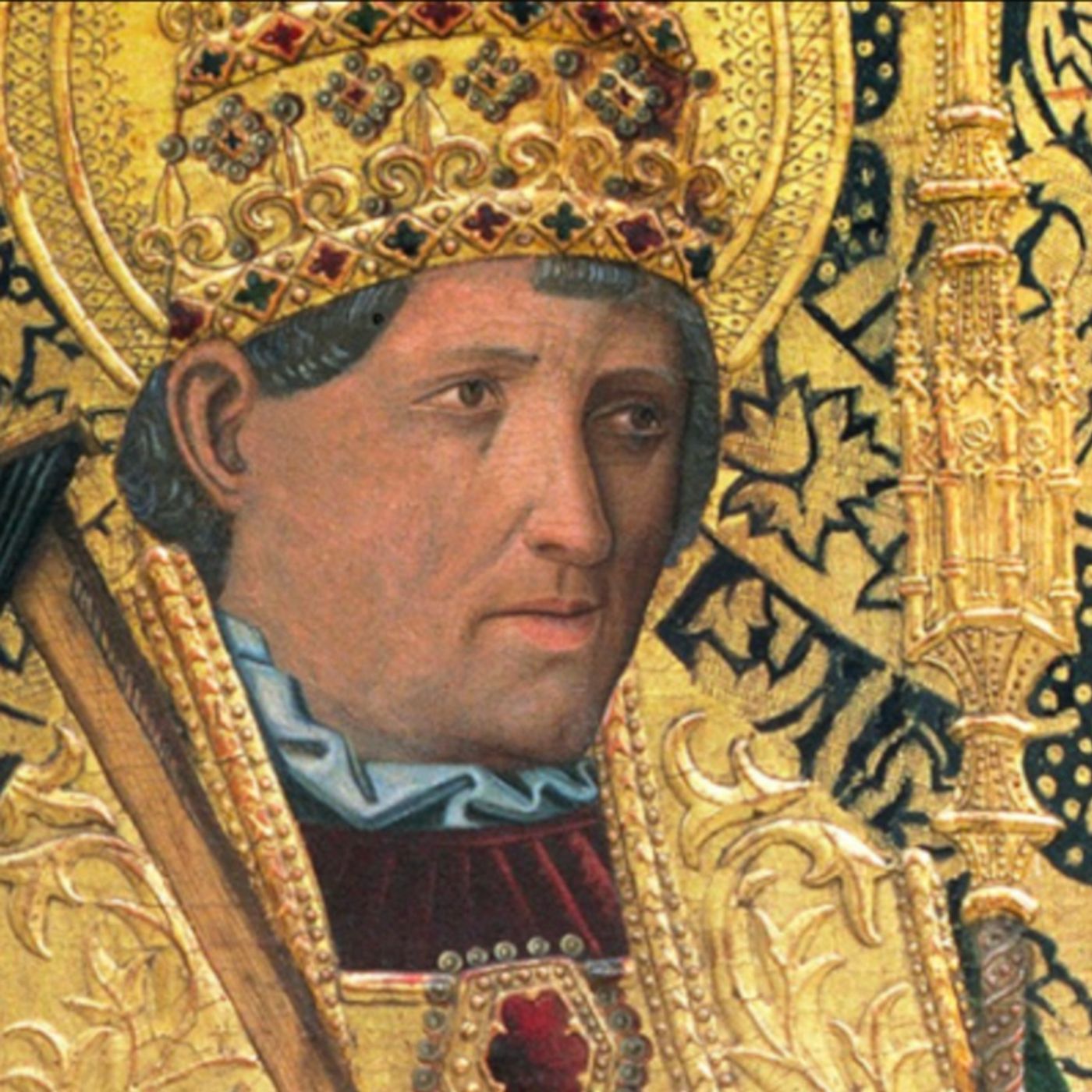
January 20: Saint Fabian, Pope and Martyr
c. 200–250
Optional Memorial; Liturgical Color: Red
Patron Saint of Rome
The popes of the third century knew how to die
In the present-day suburbs of Rome, tour buses navigate winding, narrow, tree-lined roads to carry modern pilgrims to the Catacombs of St. Callixtus. The pilgrims descend a steep staircase until they find themselves in a vast, dark, underground space. The pilgrims slowly walk by early Christian graffiti blanketing the walls to their right and to their left. Marble scraps of early Christian tombstones have etched upon them Greek and Latin epigraphs briefly describing whom they honor. In 1850 an archaeologist working in the St. Callixtus Catacombs discovered, incredibly, just such a small chunk of marble with the following simple epitaph: “Fabian, Bishop, Martyr.” The epitaph confirmed the tradition that Fabian’s lifeless body was carried in procession to these Catacombs shortly after his death in 250 A.D. In the early 1700s, Pope Fabian’s relics were transferred to the nearby Church of Saint Sebastian, where they can be found today.
According to Eusebius of Caesarea, who wrote a detailed history of the Church about fifty years after Pope Fabian’s time, Fabian was a layman who went to Rome after the death of the previous pope. He was elected Bishop of Rome due to a miraculous sign. In other words, Fabian did not strive to his high office. He did not seek to be important. He accepted his role in the full knowledge that it could lead to big trouble for him. And that trouble eventually found him.
A third-century letter of Saint Cyprian to the deacons and priests of Rome confirms the virtuous life and courageous death of Pope Fabian. Fabian reigned as Pope for fourteen years before being martyred in 250 A.D. The Roman Emperor Decius was his killer. Decius’ persecution was vicious but not universal. He tried to kill the body of the Church by cutting off the head, and so sought the Pope’s blood. But Decius’ ambitious project was never realized. About sixty-five years later, one of Decius’ successors, Constantine, would legalize Christianity, bringing to an end almost three hundred years of on-again, off-again persecution.
We can only imagine what it would be like today if the Pope were to be imprisoned and killed by the Prime Minister of Italy. Imagine the outcry! A secular power actively persecuting a religious leader! Yet perhaps such events are not so unimaginable. Pope Saint John Paul II was shot, and almost killed, in 1981, probably due to dark communist forces rooted in Eastern Europe. Assassins still exist, and popes are still their targets.
Pope Fabian’s martyrdom shows why the Church survived its early and vicious persecutions—it had leaders who knew how to die. Great deaths don’t follow shallow lives. The early popes didn’t give up or give in. They didn’t renounce the faith. They were fearless. They felt the cold, sharp metal of a knife against their neck and stood firm. A religious society with such models of courage in its highest ranks had to survive. And it did survive. We are living proof of that.
Saint Fabian, your papal death proved to the faithful that their leaders personally accepted what they demanded of others. Slaves, prisoners, women, outcasts, and popes all died for the faith. Help us, Fabian, to be further links in the Church’s long chain of Christian witnesses.
view more
c. 200–250
Optional Memorial; Liturgical Color: Red
Patron Saint of Rome
The popes of the third century knew how to die
In the present-day suburbs of Rome, tour buses navigate winding, narrow, tree-lined roads to carry modern pilgrims to the Catacombs of St. Callixtus. The pilgrims descend a steep staircase until they find themselves in a vast, dark, underground space. The pilgrims slowly walk by early Christian graffiti blanketing the walls to their right and to their left. Marble scraps of early Christian tombstones have etched upon them Greek and Latin epigraphs briefly describing whom they honor. In 1850 an archaeologist working in the St. Callixtus Catacombs discovered, incredibly, just such a small chunk of marble with the following simple epitaph: “Fabian, Bishop, Martyr.” The epitaph confirmed the tradition that Fabian’s lifeless body was carried in procession to these Catacombs shortly after his death in 250 A.D. In the early 1700s, Pope Fabian’s relics were transferred to the nearby Church of Saint Sebastian, where they can be found today.
According to Eusebius of Caesarea, who wrote a detailed history of the Church about fifty years after Pope Fabian’s time, Fabian was a layman who went to Rome after the death of the previous pope. He was elected Bishop of Rome due to a miraculous sign. In other words, Fabian did not strive to his high office. He did not seek to be important. He accepted his role in the full knowledge that it could lead to big trouble for him. And that trouble eventually found him.
A third-century letter of Saint Cyprian to the deacons and priests of Rome confirms the virtuous life and courageous death of Pope Fabian. Fabian reigned as Pope for fourteen years before being martyred in 250 A.D. The Roman Emperor Decius was his killer. Decius’ persecution was vicious but not universal. He tried to kill the body of the Church by cutting off the head, and so sought the Pope’s blood. But Decius’ ambitious project was never realized. About sixty-five years later, one of Decius’ successors, Constantine, would legalize Christianity, bringing to an end almost three hundred years of on-again, off-again persecution.
We can only imagine what it would be like today if the Pope were to be imprisoned and killed by the Prime Minister of Italy. Imagine the outcry! A secular power actively persecuting a religious leader! Yet perhaps such events are not so unimaginable. Pope Saint John Paul II was shot, and almost killed, in 1981, probably due to dark communist forces rooted in Eastern Europe. Assassins still exist, and popes are still their targets.
Pope Fabian’s martyrdom shows why the Church survived its early and vicious persecutions—it had leaders who knew how to die. Great deaths don’t follow shallow lives. The early popes didn’t give up or give in. They didn’t renounce the faith. They were fearless. They felt the cold, sharp metal of a knife against their neck and stood firm. A religious society with such models of courage in its highest ranks had to survive. And it did survive. We are living proof of that.
Saint Fabian, your papal death proved to the faithful that their leaders personally accepted what they demanded of others. Slaves, prisoners, women, outcasts, and popes all died for the faith. Help us, Fabian, to be further links in the Church’s long chain of Christian witnesses.
More Episodes
March 25: Annunciation of the Lord
 2024-04-07
2024-04-07
 2024-04-07
2024-04-07
April 5: Saint Vincent Ferrer, Priest
 2024-04-04
2024-04-04
 2024-04-04
2024-04-04
April 4: Saint Isidore, Bishop and Doctor
 2024-04-02
2024-04-02
 2024-04-02
2024-04-02
April 2: Saint Francis of Paola, Hermit
 2024-04-01
2024-04-01
 2024-04-01
2024-04-01
Palm Sunday of the Passion of the Lord
 2024-03-23
2024-03-23
 2024-03-23
2024-03-23
March 17: Saint Patrick, Bishop
 2024-03-11
2024-03-11
 2024-03-11
2024-03-11
March 9: Saint Frances of Rome, Religious
 2024-03-09
2024-03-09
 2024-03-09
2024-03-09
March 8: Saint John of God, Religious
 2024-03-07
2024-03-07
 2024-03-07
2024-03-07
March 4: Saint Casimir
 2024-03-04
2024-03-04
 2024-03-04
2024-03-04
012345678910111213141516171819
Create your
podcast in
minutes
- Full-featured podcast site
- Unlimited storage and bandwidth
- Comprehensive podcast stats
- Distribute to Apple Podcasts, Spotify, and more
- Make money with your podcast
It is Free
- Privacy Policy
- Cookie Policy
- Terms of Use
- Consent Preferences
- Copyright © 2015-2024 Podbean.com






